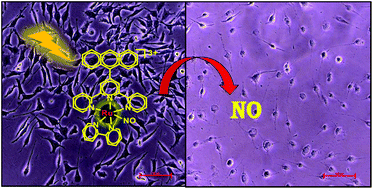Near-IR light-induced photorelease of nitric oxide (NO) on ruthenium nitrosyl complexes: formation, reactivity, and biological effects†
Abstract
Polypyridyl backbone nitrosyl complexes of ruthenium with the molecular framework [RuII(antpy)(bpy)NO+/˙]n+ [4](PF6)3 (n = 3), [4](PF6)2 (n = 2), where antpy = 4′-(anthracene-9-yl)-2,2′:6′,2′′-terpyridine and bpy = 2,2′-bipyridine, were synthesized via a stepwise synthetic route from the chloro precursor [RuII(antpy)(bpy)(Cl)](PF6) [1](PF6) and [RuII(antpy)(bpy)(CH3CN)](PF6)2 [2](PF6)2 and [RuII(antpy)(bpy)(NO2)](PF6) [3](PF6). After column chromatographic purification, all the synthesized complexes were fully characterized using different spectroscopic and analytical techniques including mass spectroscopy, 1H NMR, FT-IR and UV-vis spectrophotometry. The Ru–NO stretching frequency of [4](PF6)3 was observed at 1941 cm−1, which suggests moderately strong Ru–NO bonding. A massive shift in the νNO frequency occurred at Δν = 329 cm−1 (solid) upon reducing [4](PF6)3 to [4](PF6)2. To understand the molecular integrity of the complexes, the structure of [3](PF6) was successfully determined by X-ray crystallography. The redox properties of [4](PF6)3 were thoroughly investigated together with the other precursor complexes. The rate constants for the first-order photo-release of NO from [4](PF6)3 and [4](PF6)2 were determined to be 8.01 × 10–3 min−1 (t1/2 ∼ 86 min) and 3.27 × 10–2 min−1 (t1/2 ∼ 21 min), respectively, when exposed to a 200 W Xenon light. Additionally, the photo-cleavage of Ru–NO occurred within ∼2 h when [4](PF6)3 was irradiated with an IR light source (>700 nm) at room temperature. The first-order rate constant of 9.4 × 10–3 min−1 (t1/2 ∼ 73 min) shows the efficacy of the system and its capability to release NO in the photo-therapeutic window. The released NO triggered by light was trapped by reduced myoglobin, a biologically relevant target protein. The one-electron reduction of [4](PF6)3 to [4](PF6)2 was systematically carried out chemically (hydrazine hydrate), electrochemically and biologically. In the biological reduction, it was found that the reduction is much slower with double-stranded DNA compared to a single-stranded oligonucleotide (CAAGGCCAACCGCGAGAAGATGAC). Moreover, [4](PF6)3 exhibited significant photo-toxicity to the VCaP prostate cancer cell line upon irradiation with a visible light source (IC50 ∼ 8.97 μM).



 Please wait while we load your content...
Please wait while we load your content...